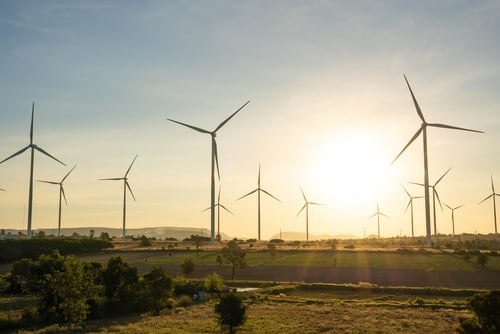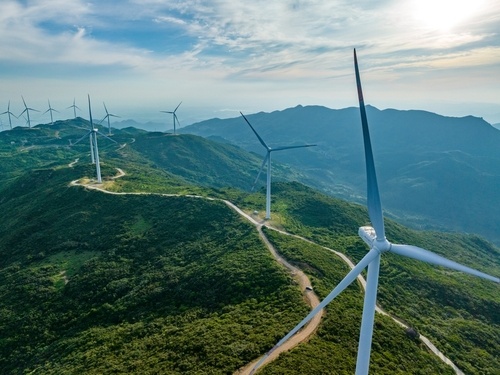As the summer season progressed a narrowing price trend emerged. The Sum-24 gas contract fluctuated 34% in Q2-23 and 20% in Q3-23. The contract has developed a strong resistance level at 145p/therm after failing to breach this mark on three occasions. Recent volatility has been sparked by supply-side factors such as extensions to Norwegian maintenance along with headlines around the resumption of potential Australian LNG strikes, suspected sabotage of the Baltic interconnector and the Middle East conflict which led UK gas prices surging by 35%. This level of volatility demonstrates how the European gas market has become structurally tighter since the Russian gas supply cuts to Europe and how any further small changes to the market balance has led to high asymmetric price risk and volatility.
Downside price risks certainly exist in the form of negative demand shocks from a recession, or from another mild winter and healthy supply volumes. However, European and Asian gas demand is already weak with price support from substantial coal to gas switching volumes across the European power sector with the first winter without German nuclear which places further reliance on alternate fuels.
DEMAND SECTION
This winter uncertainty around demand will remain a challenge in relation to weather conditions and the extent to which economic weakness will translate to continued weak gas demand. Behavioural changes have also contributed to demand reduction as people are less negligent to waste energy leading to changes in heating patterns.
UK gas demand is currently 6% above the 6-month rolling average with the strongest increases observed in LDZ demand which recently shifted above normal levels, followed by a slight increase in industrial however weakness in gas requirement from power generators persists due to healthy renewable generation and improved nuclear output.
In contrast, total monthly gas consumption in North-West Europe remains below levels observed this time last year due to continued weakness in Germany’s industrial demand. Over the past year industrial demand reduction has been linked to offshoring, shuttering in of production, energy efficiency measures and hedging constraints due to unfavourable prices over the next couple years for large manufacturing plants.
On a broader perspective, the Eurozone PMI data has also shown weakness in manufacturing, especially in Germany which accounts for almost half of North-West Europe’s industrial offtake which recently hit a 40-month low. Forward indicators such as new orders have also fallen at the fastest rate since the start of the pandemic impacted by lower consumer spending due to inflationary pressures which points to a weak macroeconomic outlook in Europe.
This winter the demand recovery in Asia is expected to be limited. China has seen a recovery in LNG imports this year however imports are forecast to moderate with the demand growth forecast to be 9% higher winter-on-winter. Other key countries such as Japan and South Korea are expected to see reduced LNG demand due to increased nuclear availability, and new coal-fired plants. Based on changes in total supply and demand, LNG imports into North-West Europe could be around 4bcm higher compared to last winter although weather patterns will be a key driver.
The ongoing El Nino event in the Eastern Pacific Ocean increases the likelihood of milder winter temperatures for China, Japan and South Korea, when observing similar events historically. In North-West Europe, longer-term weather forecasts point to low North-East Atlantic pressure driving a mild temperature scenario over the next couple of months although uncertainty over the strength of wind speeds remains, which could create high fluctuations in day-ahead markets. Forecasts into next year suggest temperatures in the UK and Europe could be volatile with the possibility of wetter and cloudy conditions which could swing gas-for-power demand.
SUPPLY SECTION
Global LNG supply is set to increase by 11.5 bcm YoY this winter, with 8.5 cm coming from the US alone following the full return of Freeport. Around 4bcm of this supply should arrive in to Europe. So far this year North-West Europe has attracted 67bcm of LNG. This highlights Europe’s progress in replacing Russian supply given that Nord Stream delivered around 59 bcm of gas into Europe in 2021.
Much of this transition has been possible due to FSRUs, of which multiple have been procured across Europe in the past year, with further units set to be online into Q1-24. Europe has also managed to secure additional longer-term LNG deals in recent months. Most recently Qatar struck two 27-year deals with Shell and Total Energies to deliver a combined 7m tonnes of LNG to the Netherlands and France. Despite this progress, 40% of LNG arriving into Europe is still bought on the spot market and so drivers in this market remain key.
Current netbacks generally favour Asian markets for Europe’s main suppliers of LNG, the US and Qatar. However, once shipping rates are accounted for European markets are currently more favourable to US exporters. Weather will be a key factor in driving spot over winter. If we do see colder temperatures in Asia, this will drive spot prices and incentivise more cargos Eastwards. Earlier this week, news of an agreement between Chevron and its Australian workers was welcome news for the Asian LNG supply picture. Further strikes have been averted and it’s hoped the agreement will be ratified without further delay. Although unions warned that if Chevron tries to alter the deal reached, workers could vote to strike again.
Norwegian flows are expected to remain steady over winter following a heavy summer maintenance schedule. Delays at Nyhamna and Troll saw capacity cut significantly compared to typical summer schedules. (The Sum-24 maintenance schedule is much lighter which will be key for replenishing storages for Win-24.Some 2.5bcm of foreign gas has been pumped into Ukrainian storage in recent weeks as Europe’s caverns reached 98% fullness, with the UK now 95% full. Current central cases forecasts put NWE storage at around 40% full at the end of Win-23, this would be just below levels at the end of Win-22.
Russian supply via Ukrainian routes remains steady and this is expected to continue until Jan-25 when current transit agreement with Ukraine ends. Gas flows could theoretically fall to zero at this point, but Russia could still book capacity at future auctions.
The picture for French nuclear has vastly improved YoY. Output currently sits at 70% of capacity, compared with just 48% in Oct-22, and current forecasts show up to 90% of capacity could be online by peak winter. This is in stark contrast to Dec-22 when just 65% of capacity was online. Whilst the supply picture fundamentally looks positive, recent geopolitical developments have injected volatility into markets due to fears of potential disruptions to European gas supplies. Damage to the Finnish/Estonia gas interconnector lately roiled markets it highlighted the remaining vulnerability of Europe’s piped gas infrastructure. The recent escalation in the Middle East has raised concerns of the conflict spreading to surrounding nations, with the potential for some key global energy players to be impacted.
WIDER MARKETS
In the wider market, Brent oil has appreciated by 22% since the start of Q3-23 with the front-month contract now trading above $91/bbl. A tighter market balance has been related to slow demand recovery as central banks hold high interest rates to tackle inflation which took the U.S dollar to an 11-month high. Meanwhile the extension to the OPEC+ supply cuts to the end of the year and U.S stocks falling to the lowest since October 2014 provides price support. Updates from the IEA and OPEC point to strong growth in global oil demand in 2023 and 2024, citing signs of a resilient world economy with China, considered the engine of oil demand growth this quarter who have started to show economic recovery in the third quarter following a series of stimulus measures.
The UK and European carbon markets have experienced a higher rate of convergence through Q3-23 with the Dec-23 EUA contract almost holding a £47/tonne premium against UKA’s in mid-September. This was due to UKA’s falling to a historic low as the UK government announced a change on several climate policies which makes the conditions to reach Net-Zero by 2050 much tougher. In contract EUA’s held onto much of its value due to the build-up of net short-short positions by investment funds and periods of TTF prices trading above the average coal switching price which is expected to remain competitive into the new year. Since this point the price spread between the two markets have narrowed to levels last observed in June as the UK government announced that the UK ETS will be tightened in 2024 by a 12.4% reduction from the current year as part of the broader ETS reform package.






